Chicken tenderloins are a versatile and lean protein source that can be cooked in various ways. Baking chicken tenderloins in the oven is a simple and healthy method that yields tender and juicy results. This cooking approach is perfect for quick weeknight dinners, meal prepping, or anyone looking for a fuss-free cooking option. With the right recipe, oven-baked chicken tenderloins can be customized to suit different tastes and preferences, making them a go-to choice for many home cooks
When it comes to crafting the perfect chicken stuffed shells, the ingredients you choose can make all the difference. I remember the first time I attempted this dish; I was overwhelmed by the variety of options available. However, I quickly learned that simplicity often yields the best results.
For a classic recipe, you’ll need jumbo pasta shells, cooked chicken (shredded or diced), ricotta cheese, mozzarella cheese, Parmesan cheese, and a jar of marinara sauce. Fresh herbs like basil and parsley can elevate the flavors, while garlic powder and onion powder add depth to the filling. What I enjoy most about this recipe is how versatile it is.
You can effortlessly adapt it using the items you already have in your kitchen. For instance, if you’re short on ricotta, cottage cheese can serve as a suitable substitute. I once made a batch using leftover rotisserie chicken, and it turned out to be a game-changer.
The convenience of pre-cooked chicken not only saved me time but also infused the dish with a rich flavor that was hard to resist. Assemble your ingredients and get set to make a delightful dish!
Table of Contents
Step-by-Step Instructions for Preparing the Chicken Filling
Elevate your dinner with the Chicken Bryan Recipe from Veibrant Recipes. This Italian-American classic features grilled chicken breasts topped with a rich lemon butter sauce, sun-dried tomatoes, and creamy goat cheese. The harmonious blend of tangy, savory, and creamy flavors makes it a gourmet addition to any meal.veibrantrecipes.com
Explore the full recipe here!
Preparing the chicken filling is where the magic begins. I usually start by shredding the cooked chicken into bite-sized pieces, ensuring that it will blend seamlessly with the other ingredients. In a big mixing bowl, I mix the chicken with ricotta cheese, a large amount of mozzarella, and a dash of Parmesan.
The first time I made this dish, I was hesitant about how much cheese to add, but I quickly learned that more is often better when it comes to cheesy goodness. Once everything is mixed together, I season the filling with salt, pepper, garlic powder, and fresh herbs. The aroma that wafts through my kitchen at this stage is simply irresistible.
I remember one evening when I was preparing this dish for friends; they couldn’t help but peek into the kitchen, drawn in by the delightful scent. After mixing everything thoroughly, I set the filling aside to let the flavors meld while I prepared the pasta shells. This step is crucial; allowing the filling to rest enhances its taste and texture.
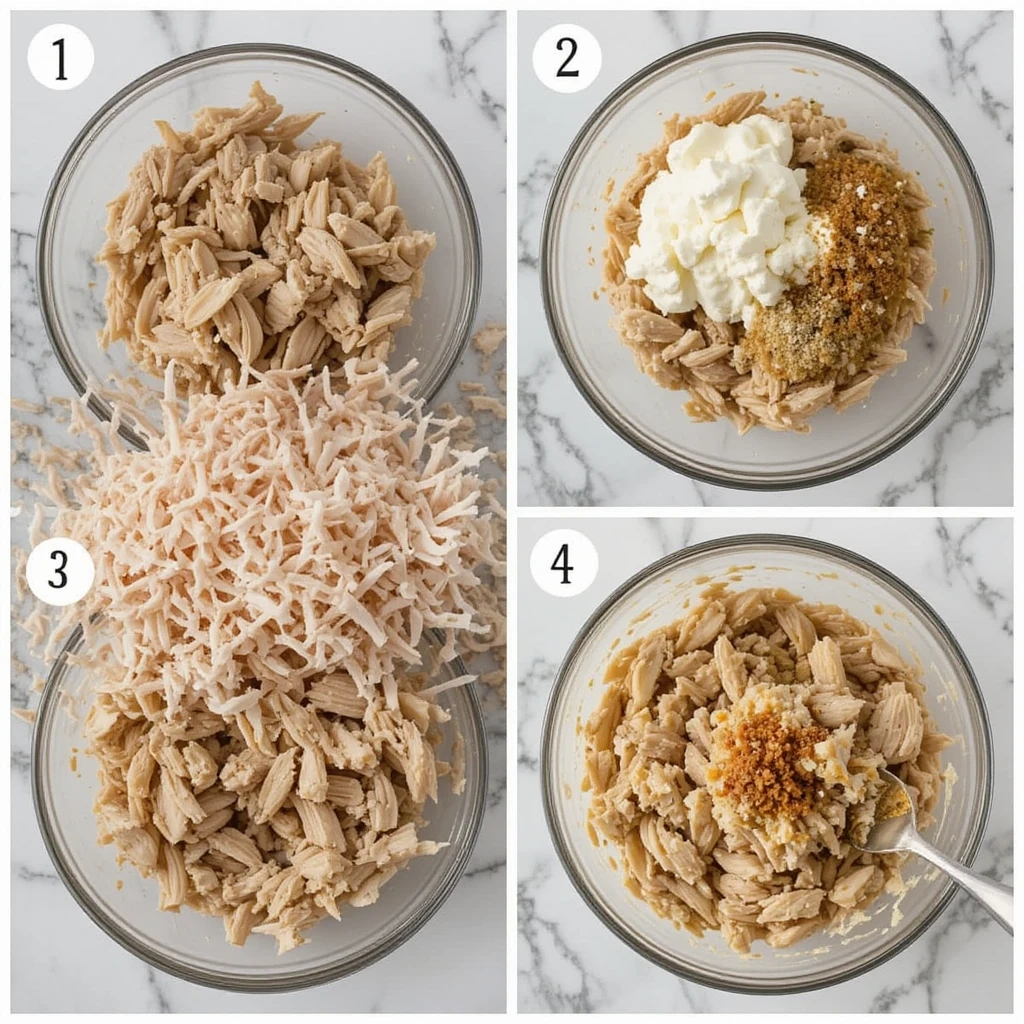
How to Cook the Pasta Shells Perfectly
Cooking the pasta shells might seem straightforward, but it’s an art in itself. The first time I made stuffed shells, I overcooked them, resulting in a mushy disaster that was far from appetizing. Now, I know that timing is everything.
I bring a large pot of salted water to a rolling boil before gently adding the jumbo shells. It’s important to stir them from time to time to avoid sticking. I usually cook them for about 8-10 minutes until they are al dente—firm enough to hold their shape but tender enough to fill.
After draining the shells, I always rinse them under cold water to stop the cooking process. This little trick has saved me from many culinary mishaps! Once they’re cool enough to handle, I lay them out on a clean kitchen towel to dry.
This step not only prevents them from sticking together but also makes it easier to fill them later on. Trust me; taking the time to cook your pasta shells perfectly will pay off in the final presentation of your dish.
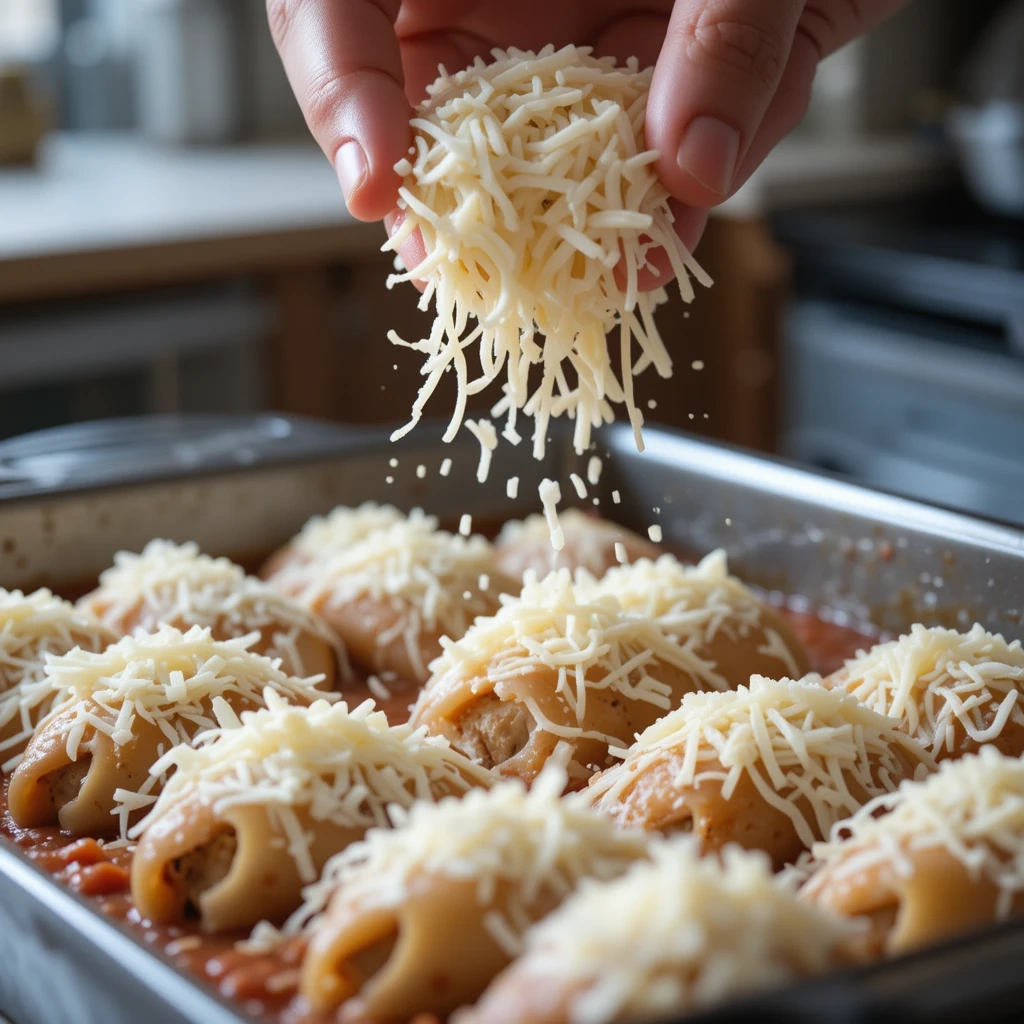
Assembling and Baking the Chicken Stuffed Shells
| Step | Time (minutes) | Difficulty Level |
|---|---|---|
| Cooking the Chicken | 20 | Medium |
| Assembling the Shells | 15 | Easy |
| Baking the Shells | 25 | Medium |
Assembling the chicken stuffed shells is where creativity meets practicality. With my filling ready and pasta shells cooked, I grab a baking dish and spread a layer of marinara sauce at the bottom—this prevents sticking and adds flavor. Then comes the fun part: filling each shell with a generous scoop of that delicious chicken mixture.
I remember my first attempt at this; I was so eager that I overstuffed some shells, leading to a messy outcome. Now, I aim for just enough filling to create a satisfying bite without overflowing. Once all the shells are filled and nestled snugly in the baking dish, I pour more marinara sauce over the top and sprinkle a final layer of mozzarella and Parmesan cheese.
The sight of that cheesy goodness bubbling in the oven is enough to make anyone’s mouth water! I bake them at 375°F for about 25-30 minutes until everything is heated through and golden brown on top. The anticipation builds as I wait for that moment when I can finally dig in.
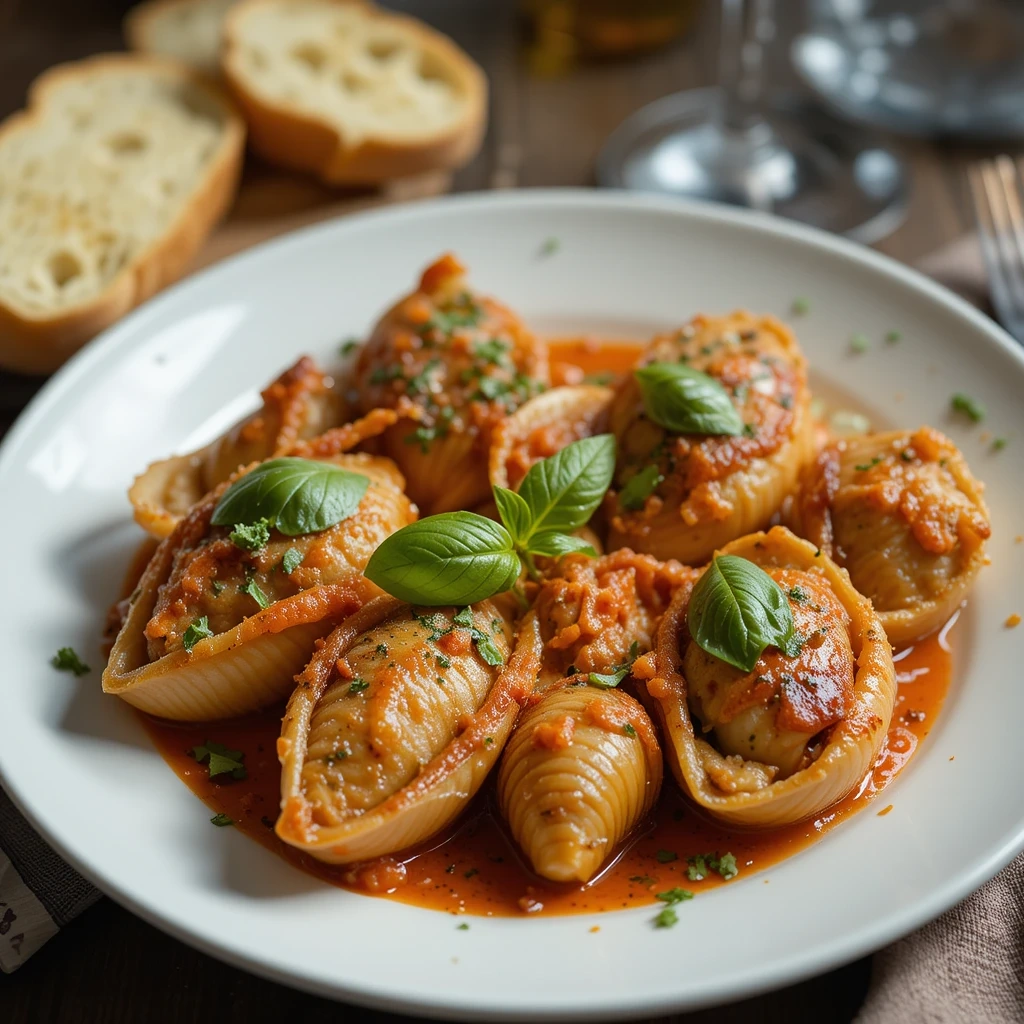
Tips for Serving and Storing the Dish
Serving chicken stuffed shells is an experience in itself. When I present this dish at gatherings or family dinners, I like to garnish it with fresh basil or parsley for a pop of color and freshness. It’s amazing how a simple herb can elevate the presentation!
I often serve it alongside a crisp green salad and some garlic bread for a complete meal that feels both comforting and indulgent. As for storing leftovers, I’ve learned a few tricks along the way. If you have any shells left after dinner (which is rare!), let them cool completely before transferring them to an airtight container.
You can refrigerate them for a maximum of three days or freeze them for prolonged storage.When reheating, I recommend adding a splash of marinara sauce to keep them moist and prevent drying out. There’s nothing quite like enjoying this dish again after a long day; it feels like a warm hug from my kitchen.
Variations and Substitutions for the Recipe
Adding a Twist to the Classic Recipe
One evening, I decided to add some wilted spinach from my fridge to the filling mixture, along with sun-dried tomatoes. The result was a vibrant and flavorful variation that my family thoroughly enjoyed! This experience has taught me that even the smallest changes can make a big difference in the overall taste and texture of the dish.
Lighter Options for a Healthier Twist
If you’re looking for a lighter take on chicken stuffed shells, consider using ground turkey or sautéed vegetables instead of chicken. These alternatives can significantly reduce the calorie count while maintaining the flavor and satisfaction of the original recipe.
Experimenting with Different Cheeses
Another way to mix things up is by using various types of cheese. I’ve found that goat cheese adds a tangy flavor that pairs beautifully with chicken, creating a unique and delicious twist on the classic recipe. The possibilities are truly endless, and each variation brings its own unique flair to this beloved dish.
5 Common Mistakes to Avoid and Their Solutions
As with any recipe, there are common pitfalls that can turn your chicken stuffed shells from delightful to disastrous. One mistake I’ve made in the past is not adequately seasoning the filling; bland food is never enjoyable! To avoid this, always taste your filling before stuffing it into the shells—adjusting seasoning as needed can make all the difference.
Another typical mistake involves either overcooking or undercooking the pasta shells. As mentioned earlier, timing is crucial here; aim for al dente pasta that will hold its shape during baking. Additionally, be cautious not to overstuff your shells; while it’s tempting to pack them full of filling, too much can lead to messy results when baking.
Lastly, don’t forget about letting your dish rest after baking; allowing it to sit for a few minutes helps everything set up nicely for serving. In conclusion, making chicken stuffed shells is not just about following a recipe; it’s about enjoying the process and creating something delicious from scratch. With these tips and tricks in mind, you’ll be well on your way to impressing family and friends with this comforting dish that’s sure to become a favorite in your home!
Looking for a comforting and hearty pasta dish? This Chicken Stuffed Shells recipe from Allrecipes combines tender chicken and savory stuffing, all nestled within jumbo pasta shells and smothered in a creamy soup-based sauce. It’s a family-friendly meal that’s both satisfying and easy to prepare, making it perfect for weeknight dinners or special occasions.Allrecipes+5Allrecipes+5Allrecipes+5
FAQs
What are the ingredients for Chicken Stuffed Shells?
The ingredients for Chicken Stuffed Shells typically include jumbo pasta shells, cooked and shredded chicken, ricotta cheese, mozzarella cheese, Parmesan cheese, egg, garlic, Italian seasoning, salt, pepper, and marinara sauce.
What are the step-by-step instructions for preparing the chicken filling?
To prepare the chicken filling for the stuffed shells, start by mixing the shredded chicken, ricotta cheese, mozzarella cheese, Parmesan cheese, egg, garlic, Italian seasoning, salt, and pepper in a bowl until well combined.
How do you cook the pasta shells perfectly?
To cook the pasta shells perfectly, bring a large pot of salted water to a boil and cook the jumbo pasta shells according to the package instructions. Be sure to cook them al dente, as they will continue to cook in the oven later.
What are the steps for assembling and baking the chicken stuffed shells?
To assemble the chicken stuffed shells, spoon marinara sauce into the bottom of a baking dish, then stuff each cooked pasta shell with the chicken filling and place them in the dish. Top with additional marinara sauce and mozzarella cheese, then bake in the oven until the cheese is melted and bubbly.
What are some tips for serving and storing the dish?
To serve the chicken stuffed shells, garnish with fresh basil or parsley and serve with a side salad or garlic bread. To store leftovers, allow the dish to cool completely, then cover and refrigerate for up to 3 days.
What are some variations and substitutions for the recipe?
Some variations and substitutions for the chicken stuffed shells recipe include using ground turkey or sausage instead of chicken, adding spinach or mushrooms to the filling, or using a different type of cheese such as fontina or provolone.
What are 5 common mistakes to avoid and their solutions?
1. Overcooking the pasta shells – Be sure to cook them al dente as they will continue to cook in the oven. 2. Not seasoning the chicken filling – Be sure to season the filling with salt, pepper, and Italian seasoning for flavor. 3. Using too much or too little sauce – Use just enough sauce to coat the bottom of the baking dish and to pour over the stuffed shells. 4. Not properly draining the cooked chicken – Be sure to drain any excess liquid from the cooked and shredded chicken before mixing it with the other filling ingredients. 5. Overcrowding the baking dish – Be sure to leave enough space between the stuffed shells in the baking dish to allow for even cooking.
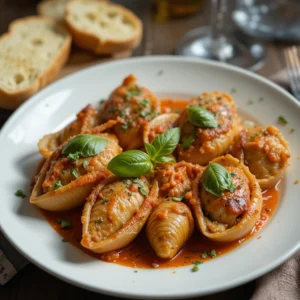
chicken stuffed shells recipe
Ingredients
- “12 jumbo pasta shells”
- “2 cups cooked chicken shredded or diced”,
- “15 ounces ricotta cheese”
- “2 cups shredded mozzarella cheese”
- “1/2 cup grated Parmesan cheese”
- “1 egg lightly beaten”,
- “2 cloves garlic minced”,
- “2 teaspoons Italian seasoning”
- “Salt and pepper to taste”
- “24 ounces marinara sauce”
- “Fresh basil or parsley for garnish optional”
- ]
- “Pros”: [
- “Versatile recipe easily adaptable to available ingredients.”,
- “Comforting and satisfying dish.”
- “Good way to use leftover chicken.”
- “Freezes well for make-ahead meals.”
- ]
- “Cons”: [
- “Can be time-consuming to assemble.”
- “Potential for mushy shells if overcooked.”
- “High in calories and fat depending on ingredients used.”
- “Requires multiple steps and dishes.”
Instructions
- “Preheat oven to 375°F (190°C). Lightly grease a 9×13 inch baking dish.”,
- “Cook jumbo pasta shells according to package directions until al dente. Drain and rinse with cold water. Set aside.”,
- “In a large bowl, combine shredded chicken, ricotta cheese, 1 cup mozzarella cheese, Parmesan cheese, egg, garlic, Italian seasoning, salt, and pepper. Mix well.”,
- “Spread a thin layer of marinara sauce on the bottom of the prepared baking dish.”,
- “Fill each cooked pasta shell with the chicken and cheese mixture. Arrange the filled shells in the baking dish.”,
- “Pour the remaining marinara sauce over the shells.”,
- “Sprinkle the remaining 1 cup of mozzarella cheese over the top.”,
- “Bake for 25-30 minutes, or until the cheese is melted, bubbly, and lightly golden brown.”,
- “Let stand for a few minutes before serving. Garnish with fresh basil or parsley, if desired.”

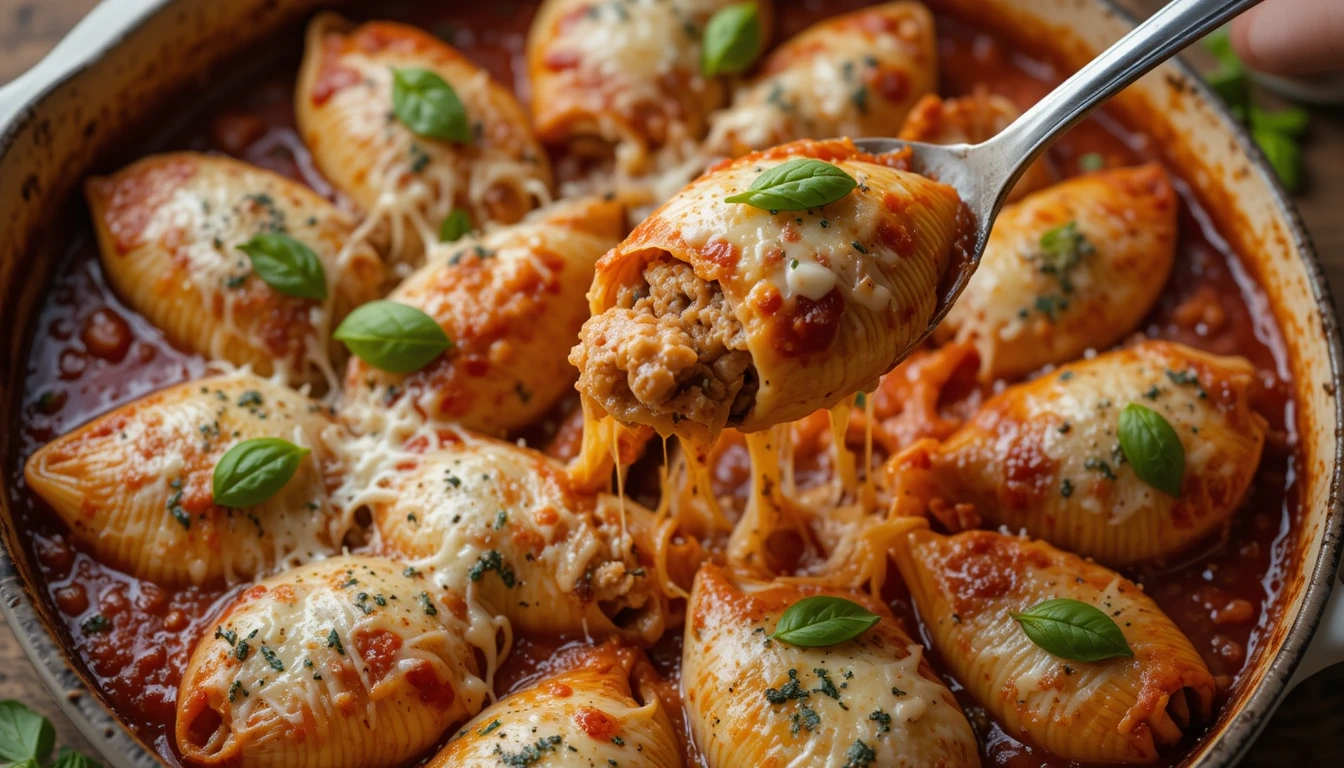
1 thought on “5 Easy Steps to Make the Best Chicken Stuffed Shells Recipe”